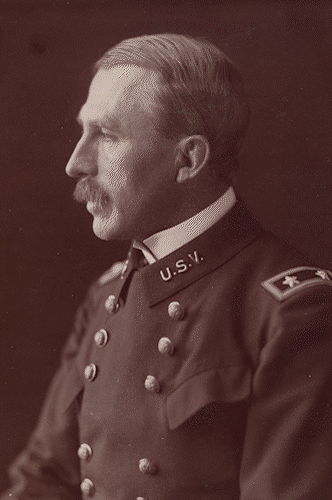FRECKLED AND BROAD-CHESTED, with fading white-blond hair and a robust mustache, «in first-rate health» from years of navigating the austere conditions of the desert Southwest, Dr. Leonard Wood rode in, quite literally, to save the day for Georgia Tech football.
The 33-year-old first lieutenant, newly settled in as a post surgeon at nearby Fort McPherson, arrived on horseback to the Georgia Tech campus in the fall of 1893. He registered as a «sub-apprentice» in a woodworking course — essentially learning cabinet and furniture making — so he could qualify as a student.
Any aspirations of becoming a master craftsman, though, were secondary. Unbeknownst to the students at that eight-year-old technical school on the northern edge of Atlanta, the man atop that steed would become their first sports star.
Wood’s story has all the elements you’ve come to expect from today’s college football melodrama. An experienced transfer, several years older than his teammates. Accusations of roster tampering. Questions of eligibility and flimsy classes. A fast turnaround to glory, followed by hot-blooded allegations from rival fans.
College football history may not repeat itself, but to paraphrase an old saying, it does rhyme. For all the wringing of hands and gnashing of teeth about the issues threatening the supposed sanctity of the modern game, it’s nothing that hadn’t happened 130 years earlier. And it happened to ensnare someone who would become Army Chief of Staff and one of the more notable U.S. political and military figures of the 20th century.
Wood competed at Georgia Tech for only one season, but he made quite an impact. Amid fistfights, thrown rocks and a drawn knife, he was the star of the first win in school history, against rival Georgia no less.
The United States observes Veterans Day on Tuesday. On Saturday, some 70 miles from where Wood grew up, his former school faces Boston College at Alumni Stadium in Chestnut Hill.
Haynes King may be Georgia Tech’s latest hard-nosed transfer hero, but he was hardly the first. Before NIL, tampering or the transfer portal, there was Wood’s spectacular, short-lived football season at Georgia Tech. His exploits during college football’s rowdy early days have resonance today.
chartered a small engineering institute named the Georgia School of Technology — he accepted a contract for $100 per month from the U.S. Army to serve as an assistant surgeon without rank for the Department of Arizona.
Wood reported to Fort Huachuca in the Arizona Territory, where he participated in the campaign to capture Geronimo in the summer of 1886 — one of the final military operations of the Apache Wars. Though he was a surgeon and not an army officer, he eventually commanded his own infantry detachment, riding up to 18 hours a day through the rugged terrain and blistering heat of Arizona and northern Mexico. His role in the Apache Wars later earned him a Congressional Medal of Honor.
«No soldier could outwalk him, could live with greater indifference on hard and scanty fare, could endure hardship better, or do better without sleep,» Theodore Roosevelt once said of him.
Olympic Club, an athletic and private social club in San Francisco, Wood’s team beat the University of California 20-10.
«Rough game, 3 men laid out,» he noted in his diary.
The entry for his son’s birth took 14 words. His recap of the Cal game took 20.
Wood quickly became hooked on the sport, finding it a worthy replacement for the strain and exertion of the Apache Wars. Wood played in several more football games over the next four months, either with the Olympic Club or teams he organized on base, including a 14-14 tie against a Stanford team coached by the legendary Walter Camp.
The following summer, in August of 1893, Wood was transferred again, this time to Fort McPherson outside Atlanta. He didn’t take the news well.
«Was never more disgusted with a post… a dull, stupid post, absolutely without interest,» he wrote in his diary.
He did, however, try to find an outlet for his boredom.
«Found a few interesting people here, and am trying to get up a little enthusiasm in football,» he added.
Wood couldn’t drum up enough interest to field a team. But 6 miles north of Fort McPherson, a football team at the nascent Georgia School of Technology was coming off a winless inaugural season. And Leonard Wood’s restlessness would soon become the team’s gain.
IN THE LINGUA franca of higher education, Wood may have charitably been described as a «nontraditional student» when he signed up for a sub-apprentice woodworking course at Georgia Tech in the fall of 1893. Georgia Tech billed its sub-apprentice class as a pathway for students whose schooling opportunities had been limited.
«No formal examinations will be held as the condition of admission,» Tech’s handbook described at the time, «although the applicant must have such knowledge of the elementary matters that will satisfy the Faculty.»
As a graduate of Harvard Medical School, surely Wood met those qualifications, though records are spotty that Wood actually attended his woodworking course.
«Using some part of occasional afternoons for that detail,» W.G. Mealor recalled of his classmate’s wood shop work in a letter to the 1933 Georgia Tech Alumnus magazine.
Besides, the woodworking class was a means to an end. Like a proto-Cardale Jones, Leonard Wood ostensibly wasn’t there to play school. He wanted to play football, and Georgia Tech had a team.
Well, not much of one. Tech’s first season in 1892, coached by professor Ernest E. West, was long on enthusiasm but low on results. The «Techs» finished with an 0-3 record, with losses to Mercer, Vanderbilt and Auburn. It would be West’s only season as head coach.
Wood offered to become a player-coach and went about organizing the «’93 Football Association.» Drawing on his experience with the Olympic Club, he quickly whipped the Techs into form. Will Hunter, a holdover from the 1892 squad, was named captain, though Wood was undeniably the star, playing left guard, halfback and kicker.
He cemented his toughness to his teammates when he opened a cut over his eye during a practice. Wood bandaged it and kept playing; according to his biographer Jack McCallum, after practice, the team found the army surgeon in front of a mirror, suturing his own laceration.
Though he started coaching and practicing earlier in the fall, Georgia Tech’s registrar’s book showed Wood wasn’t officially enrolled until Nov. 2. Coincidence or not, the team’s season opener took place two days later.
USS Leonard Wood, which earned eight battle stars for its service in World War II. The bronze, 13.5-inch-tall trophy named for another Tech coach, John Heisman, seems like a quaint honor by comparison. But to Georgia Tech fans, those achievements may pale compared to Major Gen. Leonard Wood’s greatest legacy: Leading Tech not only to its first win in school history, but a win in the first-ever edition of Clean, Old Fashioned Hate.
Controversy may have shrouded Wood’s lone month as head coach and star of the Georgia Tech football team. The only person, it seems, who had nothing to say about his career was Wood himself. There doesn’t appear to be a single quote from him about his time at Tech, either in his biography or in newspaper accounts of the day.
The Library of Congress in Washington, D.C., houses a collection of Wood’s diaries, which includes his time at Fort McPherson in 1893. However, as the library grimly notes in its transcriptions, «Pages 247-248 of the diary are missing.» Those pages covered October and November, the exact months Wood attended Tech. If he wrote anything about his playing career at Georgia Tech, it has been lost to the dustbin of history.
Even so, Leonard Wood still occupies a colorful place in college football history.
Andy Demetra is the play-by-play voice of Georgia Tech football and men’s basketball. He writes a feature column, «Inside The Chart,» on ramblinwreck.com.
















